Exploring ancient tombs can be an exhilarating way to uncover history and unravel mysteries from the past. A tomb, a word with origins from Old English and Old Norse, is a structure specifically designed for holding the remains of deceased individuals, often filled with artifacts and designs that offer insight into the culture of the time.
These burial sites are commonly associated with royalty or individuals of high importance, showcasing intricate architecture and symbolic elements. From pyramids in Egypt to mausoleums in Rome, tombs have played a significant role in preserving the legacies of the deceased for future generations to discover.
7 Examples Of Tomb Used In a Sentence For Kids
- Tomb is a building where people are buried.
- The tomb might have old pictures and writings on it.
- People visit the tomb to pay respect to those who have passed away.
- The tomb is usually made of stone or concrete.
- Some tombs are very big and magnificent.
- At the tomb, people pray and remember their loved ones.
- The tomb is a peaceful place for reflection and remembrance.
14 Sentences with Tomb Examples
- During a history field trip, the students visited an ancient tomb to learn about the architectural wonders of the past.
- The archaeology students carefully documented the hieroglyphics found inside the mysterious tomb.
- Many students were amazed by the grandeur of the marble tomb dedicated to a beloved ruler.
- The folklore class discussed the spooky legends surrounding a haunted tomb rumored to be cursed.
- Inspired by their visit to a royal tomb, the architecture students sketched designs for their upcoming project.
- The anthropology students analyzed the artifacts unearthed from an ancient burial tomb.
- As part of a research project, the students studied the significance of different symbols engraved on the walls of a remarkable tomb.
- The geology students marveled at the intricate stonework of the Rajput tomb they explored during a study tour.
- The literature students discussed the poetic inscriptions found on the walls of a stunning tomb dating back centuries.
- In their history class, the students debated the preservation efforts needed for an endangered tomb.
- The theology students contemplated the spiritual beliefs of the civilization that constructed the elaborate tomb they were studying.
- The art history students admired the intricate carvings on the pillars of an ancient Greek tomb.
- Off-campus, a group of students stumbled upon a hidden tomb nestled in the dense forest surrounding their college.
- During a photography project, the students captured the ethereal beauty of a moonlit tomb from a bygone era.
How To Use Tomb in Sentences?
Tomb is a noun that refers to a place where a dead body is buried, typically underground and marked with a tombstone. When using the word tomb in a sentence, it is important to remember its specific meaning and context.
Here are some examples of how to use tomb in a sentence:
- “The explorer discovered an ancient tomb hidden deep in the jungle.”
- “Visitors gathered around the extravagant tomb to pay their respects to the late king.”
- “The archaeological team carefully excavated the tomb to uncover its historical treasures.”
- “She left fresh flowers at her grandmother’s tomb on her birthday.”
When using tomb in a sentence, it is crucial to consider the solemn and reverent nature of the word. Tombs are often associated with death, remembrance, and historical significance, so it is essential to use the word respectfully and appropriately.
Remember to pay attention to the context in which tomb is used in order to convey the intended meaning accurately. Whether describing an ancient burial site or a modern memorial, using tomb in a sentence can add depth and significance to your writing.
Conclusion
In conclusion, sentences containing the word “tomb” commonly refer to a grave or burial place for the dead. For instance, “The ancient tomb was uncovered by archeologists.” These sentences often describe locations where remains are laid to rest or where important historical figures are memorialized. For example, “Visitors paid their respects at the tomb of the unknown soldier.” “Tomb” evokes a sense of solemnity, reverence, and historical significance, depicting a place of finality and remembrance for those who have passed away.
Whether discussing historic tombs, burial sites, or symbolic memorials, sentences featuring the word “tomb” bridge the past and present, inviting reflection on mortality, memory, and the enduring legacy of those who have come before us.



